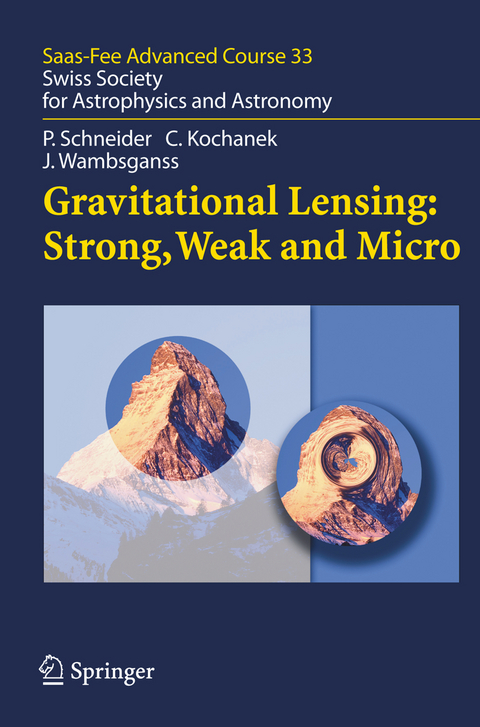
Gravitational Lensing: Strong, Weak and Micro
Saas-Fee Advanced Course 33
Seiten
2010
|
1. Softcover reprint of hardcover 1st ed. 2006
Springer Berlin (Verlag)
978-3-642-06777-8 (ISBN)
Springer Berlin (Verlag)
978-3-642-06777-8 (ISBN)
Swiss Society for Astrophysics and Astronomy
The observation, in 1919 by A.S. Eddington and collaborators, of the gra- tational de?ection of light by the Sun proved one of the many predictions of Einstein's Theory of General Relativity: The Sun was the ?rst example of a gravitational lens. In 1936, Albert Einstein published an article in which he suggested - ing stars as gravitational lenses. A year later, Fritz Zwicky pointed out that galaxies would act as lenses much more likely than stars, and also gave a list of possible applications, as a means to determine the dark matter content of galaxies and clusters of galaxies. It was only in 1979 that the ?rst example of an extragalactic gravitational lens was provided by the observation of the distant quasar QSO 0957+0561, by D. Walsh, R.F. Carswell, and R.J. Weymann. A few years later, the ?rst lens showing images in the form of arcs was detected. The theory, observations, and applications of gravitational lensing cons- tute one of the most rapidly growing branches of astrophysics. The gravi- tional de?ection of light generated by mass concentrations along a light path producesmagni?cation,multiplicity,anddistortionofimages,anddelaysp- ton propagation from one line of sight relative to another. The huge amount of scienti?c work produced over the last decade on gravitational lensing has clearly revealed its already substantial and wide impact, and its potential for future astrophysical applications.
The observation, in 1919 by A.S. Eddington and collaborators, of the gra- tational de?ection of light by the Sun proved one of the many predictions of Einstein's Theory of General Relativity: The Sun was the ?rst example of a gravitational lens. In 1936, Albert Einstein published an article in which he suggested - ing stars as gravitational lenses. A year later, Fritz Zwicky pointed out that galaxies would act as lenses much more likely than stars, and also gave a list of possible applications, as a means to determine the dark matter content of galaxies and clusters of galaxies. It was only in 1979 that the ?rst example of an extragalactic gravitational lens was provided by the observation of the distant quasar QSO 0957+0561, by D. Walsh, R.F. Carswell, and R.J. Weymann. A few years later, the ?rst lens showing images in the form of arcs was detected. The theory, observations, and applications of gravitational lensing cons- tute one of the most rapidly growing branches of astrophysics. The gravi- tional de?ection of light generated by mass concentrations along a light path producesmagni?cation,multiplicity,anddistortionofimages,anddelaysp- ton propagation from one line of sight relative to another. The huge amount of scienti?c work produced over the last decade on gravitational lensing has clearly revealed its already substantial and wide impact, and its potential for future astrophysical applications.
Peter Schneider, geboren 1940 in Lübeck, ist in Süddeutschland aufgewachsen, studierte in Freiburg Germanistik und Geschichte und lebt seit 1961 als freier Schriftsteller. 1972 Staatsexamen, 1973 Berufsverbot als Referendar. Mehrere Förderpreise; 1977/78 Stipendium der Villa Massimo. Schneiders theoretische Schriften dokumentieren den Ablauf der Studentenrevolte der späten 60er Jahre, an der er in Berlin und Italien aktiv teilnahm. Diese Erfahrungen sowie das zeitweilige Berufsverbot bestimmen seine ersten Erzählungen. 2009 erhielt er den Schubart-Literaturpreis der Stadt Aalen.
to Gravitational Lensing and Cosmology.- Strong Gravitational Lensing.- Weak Gravitational Lensing.- Gravitational Microlensing.
| Erscheint lt. Verlag | 13.11.2010 |
|---|---|
| Reihe/Serie | Saas-Fee Advanced Course |
| Zusatzinfo | XVI, 552 p. |
| Verlagsort | Berlin |
| Sprache | englisch |
| Maße | 155 x 235 mm |
| Gewicht | 1495 g |
| Themenwelt | Naturwissenschaften ► Physik / Astronomie ► Astronomie / Astrophysik |
| Schlagworte | Astronomy • astrophysics • Cosmology • Extragalactic Astronomy • Extrasolar Planets • Galactic Halos • Galaxy Clusters • Gravitational Lensing • Gravity • Microlensing |
| ISBN-10 | 3-642-06777-8 / 3642067778 |
| ISBN-13 | 978-3-642-06777-8 / 9783642067778 |
| Zustand | Neuware |
| Haben Sie eine Frage zum Produkt? |
Mehr entdecken
aus dem Bereich
aus dem Bereich
Von Hubble-, James-Webb- und anderen Großteleskopen bis zu …
Buch | Softcover (2024)
Springer (Verlag)
22,99 €
Grundlagen, Anwendungen in Astrophysik und Kosmologie sowie …
Buch | Softcover (2022)
Springer Spektrum (Verlag)
49,99 €
die Geschichte und Erforschung unserer Galaxie
Buch | Hardcover (2023)
C.Bertelsmann (Verlag)
30,00 €


